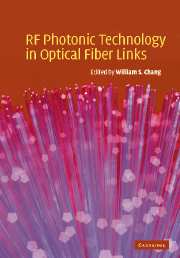Book contents
- Frontmatter
- Contents
- List of contributors
- Introduction and preface
- 1 Figures of merit and performance analysis of photonic microwave links
- 2 RF subcarrier links in local access networks
- 3 Analog modulation of semiconductor lasers
- 4 LiNbO3 external modulators and their use in high performance analog links
- 5 Broadband traveling wave modulators in LiNb03
- 6 Multiple quantum well electroabsorption modulators for RF photonic links
- 7 Polymer modulators for RF photonics
- 8 Photodiodes for high performance analog links
- 9 Opto-electronic oscillators
- 10 Photonic link techniques for microwave frequency conversion
- 11 Antenna-coupled millimeter-wave electro-optical modulators
- 12 System design and performance of wideband photonic phased array antennas
- Index
- References
9 - Opto-electronic oscillators
Published online by Cambridge University Press: 06 July 2010
- Frontmatter
- Contents
- List of contributors
- Introduction and preface
- 1 Figures of merit and performance analysis of photonic microwave links
- 2 RF subcarrier links in local access networks
- 3 Analog modulation of semiconductor lasers
- 4 LiNbO3 external modulators and their use in high performance analog links
- 5 Broadband traveling wave modulators in LiNb03
- 6 Multiple quantum well electroabsorption modulators for RF photonic links
- 7 Polymer modulators for RF photonics
- 8 Photodiodes for high performance analog links
- 9 Opto-electronic oscillators
- 10 Photonic link techniques for microwave frequency conversion
- 11 Antenna-coupled millimeter-wave electro-optical modulators
- 12 System design and performance of wideband photonic phased array antennas
- Index
- References
Summary
Introduction
Review of oscillators
Oscillators are devices that convert energy from a continuous source to a periodically varying signal. They represent the physical realization of a fundamental basis of all physics, the harmonic oscillator, and they are perhaps the most widely used devices in modern day society. Today a variety of mechanical (such as the pendulum), electromagnetic (such as LC and cavity based), and atomic (such as maser and laser) oscillators provide a diverse range in the approximation to the realization of the ideal harmonic oscillator. The degree of spectral purity and stability of the output signal of the oscillator is the measure of the accuracy of this approximation, and is fundamentally dependent on the energy storage ability of the oscillator, determined by the resistive loss (generally frequency dependent) of the various elements in the oscillator.
An important type of oscillator widely used today is the electronic oscillator. The first such oscillator was invented by L. De Forest in 1912, shortly after the development of the vacuum tube. In this triode based device known as the “van der Pol oscillator” the flux of electrons emitted by the cathode and flowing to the anode is modulated by the potential on the intervening grid. This potential is derived from the feedback of the current in the anode circuit containing an energy storage element (i.e., the frequency selecting LC filter) to the grid, as shown in Fig. 9.1a.
- Type
- Chapter
- Information
- RF Photonic Technology in Optical Fiber Links , pp. 255 - 292Publisher: Cambridge University PressPrint publication year: 2002
References
- 16
- Cited by

